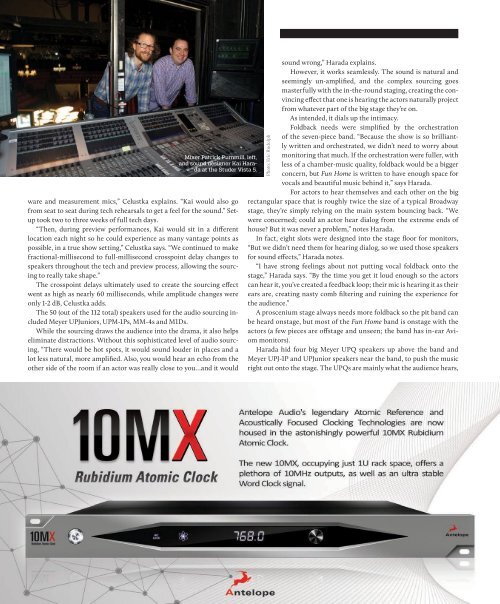Create successful ePaper yourself
Turn your PDF publications into a flip-book with our unique Google optimized e-Paper software.
Mixer Patrick Pummill, left,<br />
and sound designer Kai Harada<br />
at the Studer Vista 5.<br />
ware and measurement mics,” Celustka explains. “Kai would also go<br />
from seat to seat during tech rehearsals to get a feel for the sound.” Setup<br />
took two to three weeks of full tech days.<br />
“Then, during preview performances, Kai would sit in a different<br />
location each night so he could experience as many vantage points as<br />
possible, in a true show setting,” Celustka says. “We continued to make<br />
fractional-millisecond to full-millisecond crosspoint delay changes to<br />
speakers throughout the tech and preview process, allowing the sourcing<br />
to really take shape.”<br />
The crosspoint delays ultimately used to create the sourcing effect<br />
went as high as nearly 60 milliseconds, while amplitude changes were<br />
only 1-2 dB, Celustka adds.<br />
The 50 (out of the 112 total) speakers used for the audio sourcing included<br />
Meyer UPJuniors, UPM-1Ps, MM-4s and M1Ds.<br />
While the sourcing draws the audience into the drama, it also helps<br />
eliminate distractions. Without this sophisticated level of audio sourcing,<br />
“There would be hot spots, it would sound louder in places and a<br />
lot less natural, more amplified. Also, you would hear an echo from the<br />
other side of the room if an actor was really close to you…and it would<br />
Photo: Eric Rudolph<br />
sound wrong,” Harada explains.<br />
However, it works seamlessly. The sound is natural and<br />
seemingly un-amplified, and the complex sourcing goes<br />
masterfully with the in-the-round staging, creating the convincing<br />
effect that one is hearing the actors naturally project<br />
from whatever part of the big stage they’re on.<br />
As intended, it dials up the intimacy.<br />
Foldback needs were simplified by the orchestration<br />
of the seven-piece band. “Because the show is so brilliantly<br />
written and orchestrated, we didn’t need to worry about<br />
monitoring that much. If the orchestration were fuller, with<br />
less of a chamber-music quality, foldback would be a bigger<br />
concern, but Fun Home is written to have enough space for<br />
vocals and beautiful music behind it,” says Harada.<br />
For actors to hear themselves and each other on the big<br />
rectangular space that is roughly twice the size of a typical Broadway<br />
stage, they’re simply relying on the main system bouncing back. “We<br />
were concerned; could an actor hear dialog from the extreme ends of<br />
house? But it was never a problem,” notes Harada.<br />
In fact, eight slots were designed into the stage floor for monitors,<br />
“But we didn’t need them for hearing dialog, so we used those speakers<br />
for sound effects,” Harada notes.<br />
“I have strong feelings about not putting vocal foldback onto the<br />
stage,” Harada says. “By the time you get it loud enough so the actors<br />
can hear it, you’ve created a feedback loop; their mic is hearing it as their<br />
ears are, creating nasty comb filtering and ruining the experience for<br />
the audience.”<br />
A proscenium stage always needs more foldback so the pit band can<br />
be heard onstage, but most of the Fun Home band is onstage with the<br />
actors (a few pieces are offstage and unseen; the band has in-ear Aviom<br />
monitors).<br />
Harada hid four big Meyer UPQ speakers up above the band and<br />
Meyer UPJ-1P and UPJunior speakers near the band, to push the music<br />
right out onto the stage. The UPQs are mainly what the audience hears,


